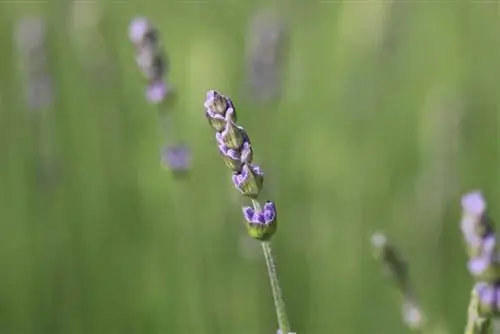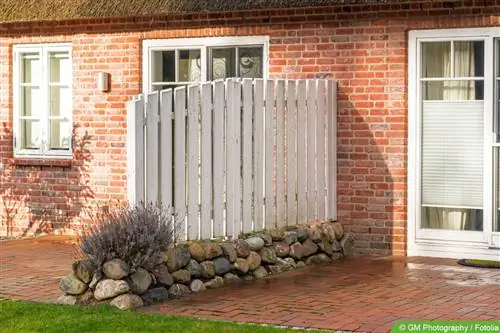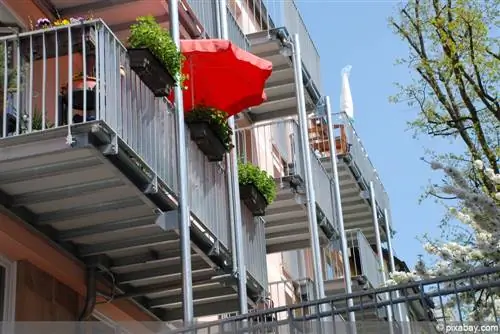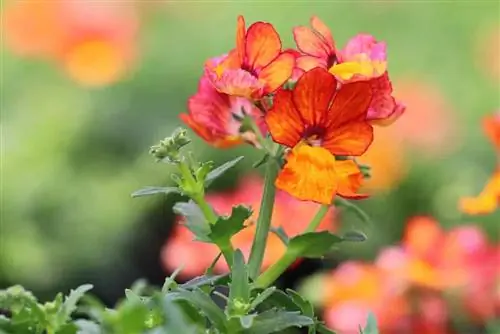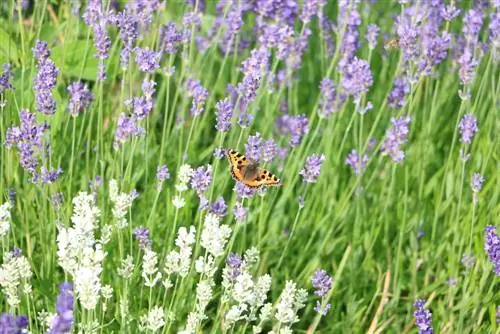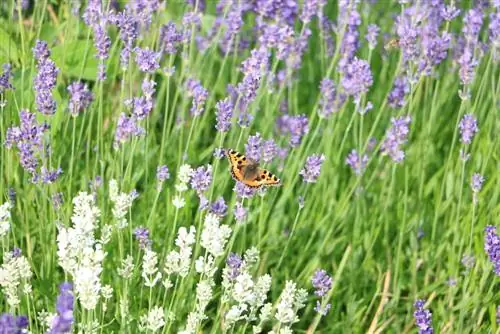- Author admin [email protected].
- Public 2023-12-17 03:39.
- Last modified 2025-06-01 06:48.
The genus “Lavendula” includes up to 37 different species, which are mainly found in warm regions such as the Mediterranean, Africa and in the south from Asia to India. A few species such as “Lavandula angustifolia” can overwinter here; other species, such as lavender, require separate locations in winter that must be frost-free. With a little care, every lavender can survive the winter months.
Frost hardness by zone
So that the lavender plants receive the right care in the cold winter months, it is important to know what type they are.how frost-resistant the plants are. Unfortunately, this information is usually very inaccurate for commercially available plants, which is why attempts are now being made to develop a uniform definition. For this purpose, the so-called winter hardiness zones were defined, which makes it possible to make general statements about the winter hardiness of plants. At the same time, suitable measures can also be taken, such as creating a microclimate, to get the lavender plants through the winter.
Central Europe is dominated by zones 4 - 11, which means a temperature range of -34.5 - +4.4°C. Lavandula angustifolia, for example, is frost-resistant up to zone 5, which means a minimum temperature resistance of up to -28.8°C. However, in this case, appropriate protective measures still need to be taken for plants on the balcony.
Difference: frost hardy and winter hardy
Frost hardiness and winter hardiness are now used as synonyms. However, winter hardiness usually includes a few other characteristics. This also includes resistance to extreme temperature fluctuations, strong wind or drought and frost. When purchasing, you should therefore pay close attention to which temperature zone the species is suitable for and what precautions need to be taken in the cold season.
Lavandula angustifolia
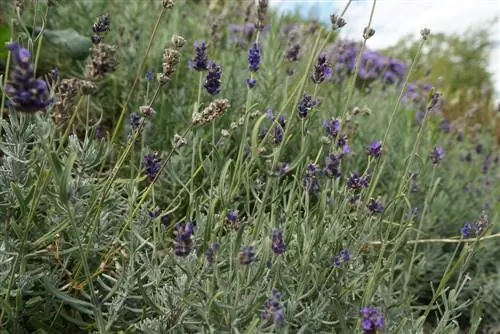
Lavandula angustifolia or real lavender is the lavender that is used in perfumery. It originally comes from the Mediterranean region, but was brought to the north by monks in the Middle Ages. There it can be overwintered outdoors in protected locations. Nevertheless, it requires special treatment, especially when grown in a pot. In winter there is a high risk that it will otherwise dry out or the root system will be damaged by frost, as it has no opportunity to root into deep layers of soil. Therefore, the root system in particular must be protected.
Prepare real lavender:
- last pruning in early autumn
- at the first frost, wrap pots with bubble wrap, straw mats, coconut mats
- use wood or styrofoam as a base
The wrapping around the pots can extend far beyond the edge of the pot. However, the plants should still receive at least indirect light. Bubble wrap is now used more often because the air-filled chambers insulate very well. The film also has the advantage that it allows light to pass through and does not provide a target for pests that can nest in natural materials such as coconut or straw. The film is also weather-resistant and can be used significantly longer than natural materials.
Tip:
A blanket of snow would provide optimal winter protection. When it snows, lavender plants can be loosely covered with snow.
Winter care of Lavandula angustifolia
Although Lavandula angustifolia can be overwintered outdoors, care should be taken to ensure it is in a protected location. This should have a constant temperature, without extremes such as direct sunlight. Temperature extremes can cause additional stress, causing plants to lose too much strength and no longer be able to withstand frost. In addition, the location should be protected from wind, especially the particularly cold east wind.
Care measures at a glance:
- check moisture regularly
- water moderately
- remove dead plant parts regularly to prevent mold formation
Tip:
The correct supply of water is often a problem during wintering on the balcony. Pots made of terracotta or clay granules can bind excess water well and gradually release it back into the substrate.
Lavandula stoechas
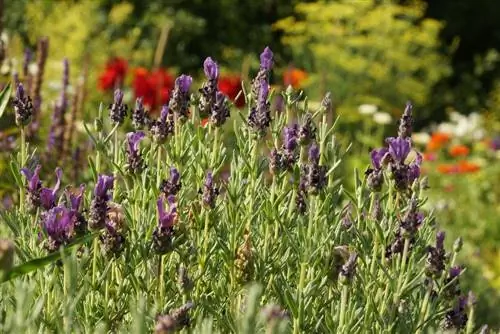
Lavandula stoechas, also known by the German name “Schopf lavender”, is also a popular ornamental plant on the balcony. This species gets its name from the inflorescences that sprout like a tuft from the top of the inflorescence. The lavender is originally native to the south of Europe and can even be found in the Canary Islands. He is an absolute lover of warmth and also specializes in dry and warm locations. This species must be wintered frost-free.
Prepare Lavandula stoechas:
strong pruning in early autumn
If necessary, repot in early autumn
Search location (conservatory, basement)
Tip:
If the roots are shortened slightly when repotting, this promotes root formation. This makes it easier for it to survive the winter months and to sprout more vigorously next spring.
If the lavender is repotted, it should not be watered too heavily in the first few weeks when it is still outdoors. Too much water reduces root formation. In addition, a lot of moisture promotes the formation of fungi, which have good opportunities to attack the open interfaces. When lavender is overwintering, it needs to be watered regularly. However, there should be no waterlogging. As a rule, it is sufficient if the plants are watered moderately once a week. Fertilization can be avoided in winter. Light fertilization in the form of liquid fertilizer can only be started in the last few weeks before the plants go outdoors again. This promotes strong budding.
Errors during wintering
Regardless of the species, serious mistakes are made again and again during overwintering, which causes the plants to die. This mainly includes incorrect pruning and watering. The plants are cut in early autumn, but only parts of the plant that would die anyway are removed. This mainly includes the inflorescences. The purpose of pruning is also to ensure that the plants do not have to produce too many leaves in winter. This would cost the plant unnecessary energy. However, the pruning must not go into woody parts.
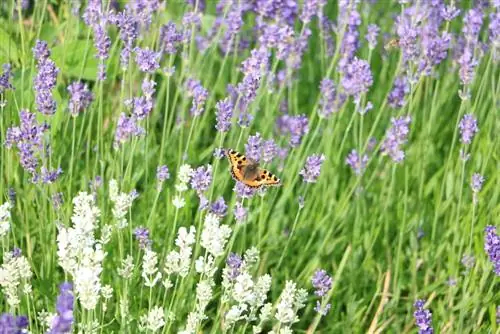
Another common mistake is a heated winter quarters. Since the plants survive on little water but value warmth very much, the warm temperatures lead to premature sprouting. This wouldn't be a problem, but the plants lack enough light. There are too few hours of sunshine, which means that the shoots wither again and the plant often dies completely.
Requirements for the winter quarters:
- bright
- frost-free
- no constant heating
- Temperature: approx. 10°C
Incorrect watering behavior is the second cause that causes plants to die. Either too much or too little is watered. If species are overwintered outdoors, the substrate must also be kept moist. When wintering indoors there is often a risk of waterlogging, which must also be avoided.
Tip:
To prevent waterlogging, place the pots on small wooden blocks in the saucers. This allows excess water to drain away and you can see immediately whether you have given too much water.
Pests and diseases in winter quarters
Another mistake is that the plants are not controlled enough in winter. Although pests rarely attack lavender, an infestation can occur in its indoor winter quarters. The temperatures also encourage the formation of mold. To ensure that problems are identified in good time, the plants must be checked regularly. In the event of pests or diseases, you must react quickly, otherwise the plants will not survive the winter. Home remedies such as a plant decoction made from nettles, which can also be prepared from the dried herb, often help with pest infestations. In the event of fungal infection, especially if it affects the roots, the plants must be immediately removed from the previous substrate. The roots are then washed off and planted in fresh substrate and a new pot. The substrate is kept only moderately moist.

